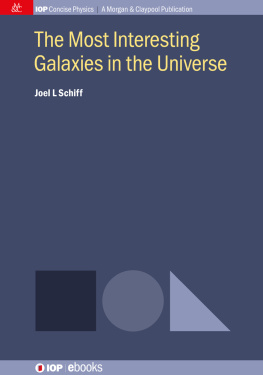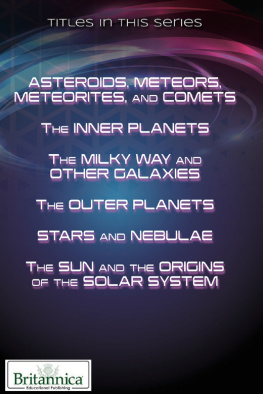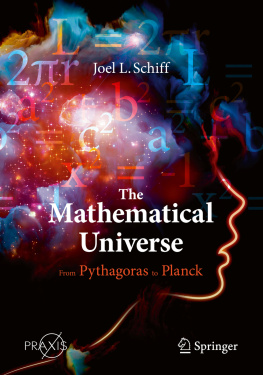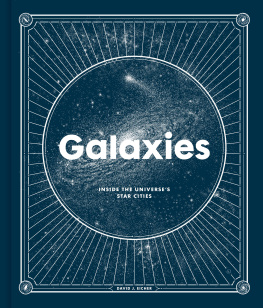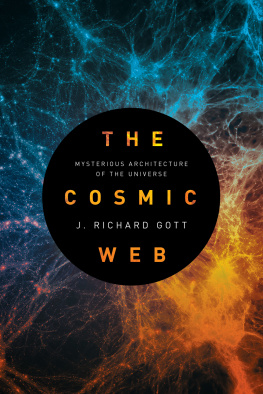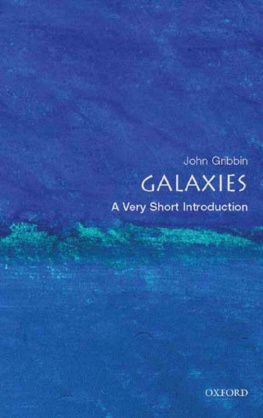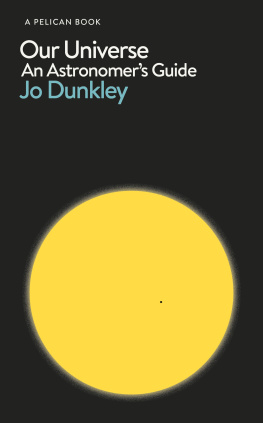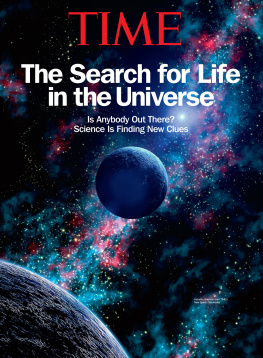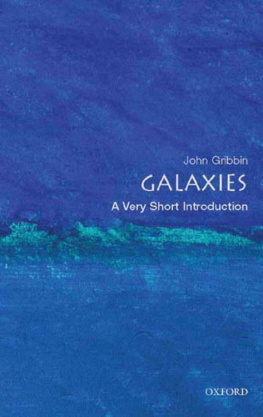Joel L Schiff - The Most Interesting Galaxies in the Universe
Here you can read online Joel L Schiff - The Most Interesting Galaxies in the Universe full text of the book (entire story) in english for free. Download pdf and epub, get meaning, cover and reviews about this ebook. year: 2018, publisher: Morgan & Claypool Publishers, genre: Children. Description of the work, (preface) as well as reviews are available. Best literature library LitArk.com created for fans of good reading and offers a wide selection of genres:
Romance novel
Science fiction
Adventure
Detective
Science
History
Home and family
Prose
Art
Politics
Computer
Non-fiction
Religion
Business
Children
Humor
Choose a favorite category and find really read worthwhile books. Enjoy immersion in the world of imagination, feel the emotions of the characters or learn something new for yourself, make an fascinating discovery.
- Book:The Most Interesting Galaxies in the Universe
- Author:
- Publisher:Morgan & Claypool Publishers
- Genre:
- Year:2018
- Rating:5 / 5
- Favourites:Add to favourites
- Your mark:
- 100
- 1
- 2
- 3
- 4
- 5
The Most Interesting Galaxies in the Universe: summary, description and annotation
We offer to read an annotation, description, summary or preface (depends on what the author of the book "The Most Interesting Galaxies in the Universe" wrote himself). If you haven't found the necessary information about the book — write in the comments, we will try to find it.
The Most Interesting Galaxies in the Universe — read online for free the complete book (whole text) full work
Below is the text of the book, divided by pages. System saving the place of the last page read, allows you to conveniently read the book "The Most Interesting Galaxies in the Universe" online for free, without having to search again every time where you left off. Put a bookmark, and you can go to the page where you finished reading at any time.
Font size:
Interval:
Bookmark:

The Most Interesting Galaxies in the Universe
Joel L Schiff
University of Auckland, New Zealand
Morgan & Claypool Publishers
Copyright 2018 Morgan & Claypool Publishers
All rights reserved. No part of this publication may be reproduced, stored in a retrieval system or transmitted in any form or by any means, electronic, mechanical, photocopying, recording or otherwise, without the prior permission of the publisher, or as expressly permitted by law or under terms agreed with the appropriate rights organization. Multiple copying is permitted in accordance with the terms of licences issued by the Copyright Licensing Agency, the Copyright Clearance Centre and other reproduction rights organisations.
Rights & Permissions
To obtain permission to re-use copyrighted material from Morgan & Claypool Publishers, please contact .
ISBN 978-1-64327-004-3 (ebook)
ISBN 978-1-6432-7001-2 (print)
ISBN 978-1-6432-7002-9 (mobi)
DOI 10.1088/978-1-64327-004-3
Version: 20180901
IOP Concise Physics
ISSN 2053-2571 (online)
ISSN 2054-7307 (print)
A Morgan & Claypool publication as part of IOP Concise Physics
Published by Morgan & Claypool Publishers, 1210 Fifth Avenue, Suite 250, San Rafael, CA, 94901, USA
IOP Publishing, Temple Circus, Temple Way, Bristol BS1 6HG, UK
Print cover image: The shell galaxy NGC 474. Credit: Canada-France-Hawaii Telescope/ J-C Cuillandre & G Anselmi (Coelum).
Open your eyes and see what you can with them before they close forever.
All the Light We Cannot See by Anthony Doerr
Dedicated to Beatrice Muriel Hill Tinsley (19411981), a scholar from New Zealand who made very significant contributions to the study of galaxy evolution and cosmology, but who left our world all too soon.

Beatrice Tinsley at Yale University in 1978. Credit: Encyclopedia of New Zealand.
Mankind has no doubt pondered the origin of the Universe, well, since the beginning of mankind. The notion that the world is borne on the back of a turtle who is borne on the back of another turtle, and so on in an infinite regress of turtles all the way down is a historically fanciful myth but nothing more. However, as it turns out, the standard scientific model of the Universe actually has rather extraordinary and unusual features. Indeed, any study of the Universe and its contents requires the reader to become a time traveler, peering back to periods of millions and even billions of years ago. Indeed, there is no experience of now elsewhere in the Universe, only then.
Moreover, even the very notion of space itself is somewhat bizarre, because it happens to be expanding like a rubber band. How can empty space expand? Well, it is, and pushing nearly all the galaxies in the Universe away from us. As well, all the evidence suggests that the expansion rate is actually increasing because so-called empty space is teeming with a mysterious force called dark energy driving this expansion.
When we add in the very strange feature of invisible black holes, supermassive ones that are millions to billions of times the mass of our Sun, that suck in anything in their vicinity never to be seen again, then the idea of turtles all the way down is not so strange after all.
******
This book covers the fifty-one most interesting galaxies in the Universe according to the author. Of course, there is no such thing as most interesting since every galaxy is interesting in its own right simply by being that most extraordinary structure called a galaxy. So the choice is somewhat arbitrary, but in each case, it is explained what characteristics make that particular galaxy special. And believe me, many are indeed exceptional while some are still the subject of scientific discussion as to what we are truly looking at.
The first part of the book is a very brief introduction to astronomy in order to appreciate the science involved for each galaxy. This discussion must necessarily be very incomplete but any astronomy book can be a useful source to fill in the gaps. Only enough is explained in order to understand the discussions in the section on galaxies.
As astronomy is a very scientific pursuit, there is normally a considerable amount of mathematics involved. In this book, however, the author has attempted to give the flavor of the scientific arguments by sparingly using only the simplest of mathematical equations and calculations. Where some basic mathematics is involved (logarithms, algebra, etc), those calculations are reserved for the appendices. But again, they are very elementary in nature and the reader should not be intimated by the appearance of a few symbols. Nothing more than a high school acquaintance with some of the concepts involved is required and from such simple notions as the equation of a straight line and a logarithm, one can calculate the mass of a black hole at the center of a galaxy. Now that is pretty extraordinary as well.
A few astronomical terms
The one basic notion at the heart of all astronomy is distance. How far away is a star or galaxy? And because the Universe is so vast, the units we ordinarily measure distance with, such as kilometers or miles, are simply inadequate. So there is a more useful concept and that is the light-year, namely the distance that light travels in an entire year. Light (in a vacuum) has a constant speed of 299 792.458 km s1 (km/sec), which we will round off to 300 000 km s1. That is roughly 7 times around the Earth in one second! So you can see that in an entire year, light will travel some considerable distance, roughly 9.5 trillion kilometers or 5.88 trillion miles. So we will abandon kilometers and miles as they are astronomically useless and use the distance concept of a light-year.
Thus, the distance to the nearest star Proxima Centauri is 4.2 light-years, a nice and small number to work with. The distance to the nearby galaxy Andromeda is 2.5 million light-years, again a manageable distance value. On the other hand, astronomers find it more convenient for technical reasons to use a different distance unit instead of the light-year, called a parsec. Traditionally, it has been defined as the distance to an astronomical object that has a parallax of one arcsecond as seen from Earth. The name is derived from parallax and (arc)second and 1 parsec = 3.26 light-years. But throughout this book, we will persist with the more familiar light-year unit of measurement and if necessary make the standard conversion from parsecs to light-years. The notion of parallax will be discussed in the sequel because it is an important one in measuring the distance to stars and galaxies.
One thing that the reader must appreciate is that when one looks up at the Heavens, you are peering into a time machine. To say that Proxima Centauri is 4.2 light-years away means that the light reaching our eyes when we look through a telescope has taken 4.2 years to reach us. That is why the unit of light-years is so useful. It not only conveys the distance to an object but also how many years back in time we are actually seeing it. This is called the lookback time. So, if a galaxy is 40 million light-years away, any image of it shows it as it was 40 million years ago. In this sense, we are time travelers when peering into the Universe.
This can sound problematic as perhaps the galaxy is no longer even there after 40 million years. Indeed, some of the galaxies we consider are colliding with other galaxies and what their present state is
Font size:
Interval:
Bookmark:
Similar books «The Most Interesting Galaxies in the Universe»
Look at similar books to The Most Interesting Galaxies in the Universe. We have selected literature similar in name and meaning in the hope of providing readers with more options to find new, interesting, not yet read works.
Discussion, reviews of the book The Most Interesting Galaxies in the Universe and just readers' own opinions. Leave your comments, write what you think about the work, its meaning or the main characters. Specify what exactly you liked and what you didn't like, and why you think so.

